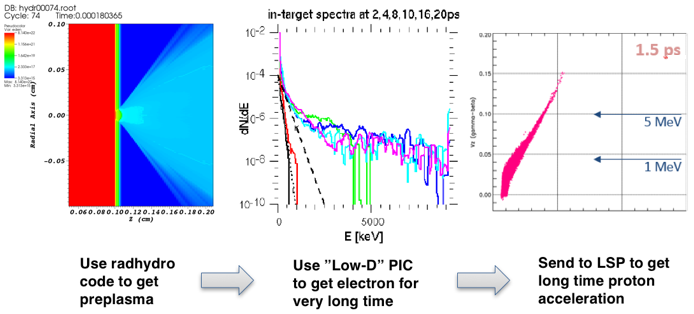Tammy Ma (17-ERD-039)
Executive Summary
We are developing a short-pulse laser-driven particle beam capability that will expand the exploration of high-energy-density physics of ultra-extreme states of matter. By enabling applications such as proton and neutron radiography, multi-view tomography, and unique nuclear reactions, this research supports stockpile stewardship.
Project Description
Ion acceleration driven by short-pulse high-intensity lasers and their applications are an increasingly active area of research and development. Our project aims to develop and explore a short-pulse laser-driven particle beam capability at Lawrence Livermore's National Ignition Facility (NIF) that will enable new high-energy-density-science of ultra-extreme states of matter. Coupled to the NIF, the Advanced Radiographic Capability (ARC) opens a new regime of hot dense matter. The ARC laser differs from other short-pulse lasers because of its higher energy, longer pulse duration, and larger focal spot. Achievable intensities are within the range to allow the acceleration of protons by a mechanism in which hot electrons generated from the intense laser–matter interaction create an accelerating sheath electric field normal to the target surface. Protons, which have the highest charge-to-mass ratio, are preferentially accelerated from the contamination layer of proton-rich hydrocarbons and water that coat the target surface. This process allows for significantly extending the energy and pulse duration range over which proton scaling is experimentally investigated. We plan to develop and optimize this proton acceleration technique using the ARC with experiments enabled by the NIF. We intend to explore the scaling physics of proton, light ion, and neutron generation at unique laser scales made possible with the ARC, using both demonstrated techniques for particle acceleration and innovative ideas to achieve unprecedented particle yields and energies. These particle beams will be characterized and optimized, then applied in a proof-of-principle demonstration of isochoric (constant-volume process) heating of a solid target. This work will enable applications from equation-of-state studies to unique nuclear reactions.
We expect to (1) produce the highest-charge picosecond-class proton beam to date with a current density greater than 1010 A/cm2, a high flux yield greater than 1014 protons above 1 MeV, and a broadband energy spectrum with a characteristic temperature of several megaelectrovolts; (2) deliver a robust and well-characterized proton acceleration platform for the ARC; (3) explore proton beam optimization; (3) develop accompanying light-ion diagnostics; (4) validate state-of-the-art hybrid particle-in-cell and kinetics modeling codes for energetic particle beam generation and characteristics in this laser regime; (5) employ these codes to explore new ideas for increasing ARC laser intensity; (6) demonstrate a high-flux deuteron beam source for creating directed neutron beams as well as a proof-of-principle isochoric heating platform; and (7) make these capabilities available to facility users and experimental teams.
Mission Relevance
Our efforts to develop a short-pulse, laser-driven particle beam capability and to expand the scientific use of the ARC beyond radiography supports NNSA's goal to strengthen the science, technology, and engineering base. This research also supports the Laboratory's core competency in high-energy-density science and supports the research-and-development challenge of stockpile stewardship.
FY17 Accomplishments and Results
In FY17 we (1) submitted an FY18 Discovery Science proposal and were awarded three ARC shot days; (2) began developing a shot plan, target design, and diagnostics; (3) initiated an experiment at Lawrence Livermore's Titan facility to investigate plasma mirror longevity and focusing properties of ellipsoidal plasma mirrors; and (4) started simulations to model the prepulse on the ARC, study beamlet overlap, and study detailed (explicit) laser–solid interactions.
Publications and Presentations
Bhutwala, K., et al. 2017. "Prediction of Scaling Physics Laws for Proton Acceleration with Extended Parameter Space of the NIF ARC." 59th Annual Meetings of the APS Division of Plasma Physics, Milwaukee, WI, 23–27 October 2017. LLNL-ABS-734826.
Candeias Lemos, N. R. 2017. "Simulating Proton Acceleration on NIF/ARC." LLNL-PROP-733701.
Candeias Lemos, N., et al., 2017. "Proton Radiography of Target Normal Sheath Acceleration Fields in the Long Pulse Regime." LLNL-PROP-729366.
Hermann, M. 2017. "Monte Carlo Analysis of Timing & Pointing Errors on Peak Intensity at TCC—Strategy to get to 1019 W/cm2." LLNL-PRES-728704.
Kemp, A., and T. Ma. 2017. "Laser Plasma Interaction Near the Relativistic Threshold." LLNL-PRES-728779.
Ma, T. 2017. "ARC Short-Pulse Laser-driven Proton Beams for Novel HED and ICF Applications." LLNL-PRES-726788.
——— 2017. "Exploration of Plasma Optics for Increasing NIF ARC Intensity." LLNL-PRES-738181.
——— 2017. "Recent Results and Future Prospects for HEDP on the NIF ARC Laser." LLNL-PRES-740304.
Ma, T., et al. 2017. "Exploration of Plasma Optics for Increasing NIF ARC Intensity." IFSA2017, September 11–15, 2017. Saint Malo, France. LLNL-ABS-730473.
Mariscal, D. 2017. "ARC-Driven Deuteron Beams for Directed High Energy Neutron Beams and Nuclear Reaction Experiments." LLNL-PROP-738445.
——— 2017. "ARC-driven Proton Beams for Probing and Driving High-Energy-Density Experiments on the NIF." LLNL-PRES-739108.
Mariscal, D., et al. 2017. "ARC-Driven Proton Beams for Driving and Probing High-Energy-Density Experiments on the NIF." LLNL-POST-734151.
——— 2017. "ARC-Driven Proton Beams for Probing and Driving High-Energy-Density Experiments on the NIF." Sixth International Conference on High Energy Density Physics, June 5–9, 2017. Wakayama, Japan. LLNL-ABS-727219.
Wilks, S. C. 2017. "Proton and Ion Acceleration using Multi-kJ Lasers." LLNL-PRES-740481.
Wilks, S. C., et al. 2017. "Proton and Ion Acceleration from Multi-kJ Lasers." APS-DPP 2017 Meeting, October 23–27, 2017. Milwaukee, WI. LLNL-ABS-734815.
   





